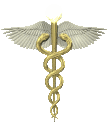|
|
Healing With a Native Touch
Andrew Stevens heads into career as a surgeon without turning
his back on possible alternatives
by Dorreen Yellow Bird Herald Staff Writer
 When Andrew
Stevens walks across the stage today, he will be one of 61 UND medical school graduates to receive his doctor of
medicine degree. He also will be one of eight Native American students to receive that degree. When Andrew
Stevens walks across the stage today, he will be one of 61 UND medical school graduates to receive his doctor of
medicine degree. He also will be one of eight Native American students to receive that degree.While it is not unusual for a Native American to receive a medical degree -- the Indians Into Medicine (INMED) program counts about 123 graduates with medical degrees since its inception in 1973 -- it is unusual for a student to think in terms of surgery while accepting Native healing as a possible alternative. For Stevens, who is Cheyenne and Arapaho from Oklahoma, becoming a surgeon has been his goal since he was 12, when surgery saved his mother's life -- or at least prolonged it for 17 years. He didn't know how ill his mother was at that time. He knew only that she spent a lot of time in and out of hospitals. It wasn't until several years later that he realized it was liver failure. It was his upbringing that helped him in medical school, Stevens said. "My mother was an educator and she instilled in me that work ethic. His father, Levi, was an administrator for the Tonkawa tribe, he said. He taught Stevens about Indian sovereignty and self-sufficiency. Stevens was about 10 when his mother's liver started to fail. The treatment choices were few. The doctors said she could undergo an experimental operation for her liver and possibly die on the operating table because it was such a new procedure, but without the surgery, she might die within a month or two. His parents "didn't gloss over things with me," he said. They told him all they knew about her medical problem. "My mother asked me if she should go ahead with the operation." Stevens said yes. It was that surgery that had a profound affect on him. "I would rather solve a problem right away with surgery than manage someone," he said. He is impatient. It's his personality, Stevens said. How does Stevens couple Native healing with his career in surgery? "If an individual really believes in it," he said, "I think it can help them." He grew up with a mother who was an advocate for Native medicine and healing. His formative years were influenced by her. She was a traditional Ponca woman, he said. They lived near her people and went to dances and ceremonies throughout the year. His father, who was full-blood Tonkawa, was more mainstream, but he knew his culture. Stevens credits INMED for getting him to UND. He wanted to attend a school that had other Native Americans. He knew that the Dakotas and Minnesota had Native Americans in their programs. He was also accepted by the University of Minnesota.  After chalking up a long list of awards and honors as student, he will began a residency at the
University of Missouri in Columbia. He was "matched" with that program. Matching means both student and
the residency program agree that they want to work together. After chalking up a long list of awards and honors as student, he will began a residency at the
University of Missouri in Columbia. He was "matched" with that program. Matching means both student and
the residency program agree that they want to work together."Surgery requires long and hard work," said Judy DeMers, associate dean for student affairs at UND's School of Medicine and Health Sciences. Only four students, including Stevens, are graduating in that field. Surgery requires five or more years in residency, she said, while fields like family practice and pediatrics usually require three years. "Andrew's strong work ethnic; willingness to accept responsibility for his own learning; his ability to work well with others and as a member of a team, and his thorough, thoughtful and caring approach to his patients and his work are all predictors of success," DeMers said. Stevens is married to Cindi Tahmahkera, who is Comanche. She will graduate from North Dakota State University in May. They have three children: Pierce Andrew, Parker Ann and Derrick. |
|
|
| Canku Ota is a free Newsletter celebrating Native America, its traditions and accomplishments . We do not provide subscriber or visitor names to anyone. Some articles presented in Canku Ota may contain copyright material. We have received appropriate permissions for republishing any articles. Material appearing here is distributed without profit or monetary gain to those who have expressed an interest. This is in accordance with Title 17 U.S.C. section 107. |
|
Canku Ota is a copyright of Vicki Lockard and Paul Barry. |
|